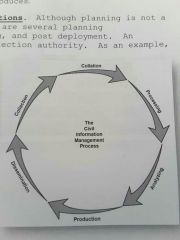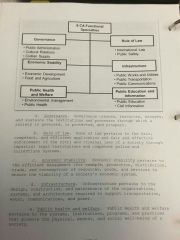![]()
![]()
![]()
Use LEFT and RIGHT arrow keys to navigate between flashcards;
Use UP and DOWN arrow keys to flip the card;
H to show hint;
A reads text to speech;
45 Cards in this Set
- Front
- Back
|
1) Define Civil Military Operations |
CMO are the activities of a commander performed by designated CA or other military forces that establish, maintain, influence, or exploit relationships between military forces and indigenous populations and institutions (IPI), by directly supporting the attainment of objectives relating to the reestablishment of maintenance of stability within a region or HN. |
|
|
1) Identify geographical locations of CA units |
Reserve 1st CAG: Camp Pendleton, CA 2d CAG: Anacostia, Washington, DC 3d CAG: Great Lakes Naval Station, IL 4th CAG: Hialeah, FL
Active I MEF CA Det: Camp Pendleton, CA II MEF CA Det: Camp Lejeune, NC III MEF CA Det: Okinawa, Japan |
|
|
1) Identify the Composition of CA teams |
AC CA Teams: 7 (1/6) RC CA Teams: 5 (2/3) |
|
|
1) Define the six steps of the Civil Affairs Methodology |
AD3ET
Assess Decide Develop/Detect Deliver Evaluate Transition |
|
|
1) Define METT-TC |
Mission Enemy Terrain and Weather Troops and Support Available Time Civil Considerations |
|
|
1) Define the components of ASCOPE/PMESII |
Civil Considerations: ASCOPE Area Structures Capabilities Organizations People Events
Operational Variables: PMESII-PT Political Military Economic Social Information Infrastructure Physical Environment Time |
|
|
1) Define the purpose of an area study |
To assist the commander in preparing initial CMO estimates. It is the foundation for all other assessments. |
|
|
1) Identify Types of Assessments |
Preliminary Assessment Deliberate Assessment -Initial Assessment -Rapid Assessment -Survey *Tactical Conflict Survey |
|
|
1) *Define the basic services necessary to sustain a local population |
Critical Infrastructure (basic services) consists of the facilities (municipal or private) that allow for the provision of basic services which sustain a populace or society.
SWEAT-MSO Sewage Water Electricity Academics Trash Medical Safety Other Services |
|
|
1) Identify Tactical Conflict Survey Questions |
Has the number of people in the village changed in the last year? Why? What are the most important problems facing the village? Why? Who do you believe can solve your problems? Why? What should be done first to help the village? Why? |
|
|
1) Identify the steps in the briefing process |
Plan Prepare Execute Assess |
|
|
1) Identify the types of military briefings? |
Information Decision Mission Staff
Purposes: -to inform -to persuade -to direct |
|
|
1) Identify the categories of shared understanding |
Data (is processed into) Information (Analyzed into) Knowledge (put in context to become) Understanding (is combined with experience to visualize situation/problem) Wisdom (is used to make decisions) |
|
|
1) Define information quality characteristics |

|
|
|
1) Identify the IM Principles |
Define the information flow with prioritized requirements Seek and deliver quality information Use multiple sources of information Deliver timely and usable formats Identify and trap errors Protect Information throughout its lifecycle Build understanding from the bottom up Decentralize information management execution Reduce complexity Tailor Information for intended audienceSet conditions for information development and sharing |
|
|
1) Define the six step CIM process |

|
|
|
1) Define the purpose of a CMO report |
The purpose of a CMO report is to capture CMO activities within the area of operations during a specified time period. |
|
|
1) Identify interagency stakeholders |
Interagency = USG
DHS FEMA USCG DoS USAID DoJ FBI DEA USDA |
|
|
1) Identify the responsibilities of the ambassador |
The Ambassador provides overall direction, coordination, and supervision of U.S. Government activities and personnel in a host country.
The ambassador (COM) has authority over all USGpersonnel in a country, except for those assigned to a combatant commant, a USG multilateral mission, or an IGO. |
|
|
1) Identify intergovernmental organizations |
An IGO is an organization created by a formal agreement between two or more governments.
NATO African Union UN |
|
|
1) Define interorganizational coordination |
The interaction that occurs among elements of the DOD; engaged USG agencies; state, territorial, local and tribal agencies; foreign military forces and government agencies; Intergovernmental orginazations; Nongovernmental organizations and the private sector. |
|
|
1) Identify Non-governmental Organizations (NGOs) |
A private, self-governing, not-for-profit organization dedicated to alleviating human suffering; and/or promoting education, health care, economic development, environmental protection, human rights, and conflict resolution; and/or encouraging the establishment of democratic institutions and civil society. |
|
|
1) Identify interorganizational coordination considerations |
Identification Mandates Perceptions Assistance Resourcing Common Ground Coordination Mechanisms Cooperation Security Clearances Oslo Guidelines |
|
|
Define Nation Assistance (NA) |
Civil and/or military assistance (OTHER THAN FHA) rendered to a nation by U.S. forces within that nation's territory during peacetime, crisis or emergencies, or war based on agreements mutually concluded between the U.S. and sustainable development and growth of responsive institutions. |
|
|
Identify NA programs |
Security Assistance (SA) Foreign Internal Defense (FID) Military Civic Action (MCA) Humanitarian Civic Assistance (HCA) |
|
|
1) Define the five dimensions of operational culture |
Physical Environment Economy Social Organization Political Structures Belief Systems |
|
|
1) Identify cultural considerations regarding the physical environment |
Water Land Food Materials for shelter Fuel/power Transportation Communications |
|
|
1) Identify cultural considerations regarding the economy |
Goods and Services Economic Exchanges *Informal Economies: Not always bad, unregulated and not monitored by the government, can be illegal Network of Exchange Structuring Social Relationships |
|
|
1) Identify cultural considerations regarding the social structure |
Social Structure= the ways in which people distribute status and power Age Gender Tribal/Kinship Class Ethnicity Religious Membership |
|
|
1) Identify cultural considerations regarding Political Structures |
Culture and Authority / Leadership Leadership Law Conflict over power |
|
|
1) Identify cultural considerations regarding Cultural Belief Systems |
Beliefs and Behavior Religious Beliefs |
|
|
Identify support to civil administration (SCA) operational environments |
Friendly Territory Occupied Territory |
|
|
Define Support to Civil Administration (SCA) |
Military operations that help to stabilize or continue the operations of a governing body or civil structure of a foreign country, whether by establishing military authority over an occupied population. |
|
|
Identify CA supporting tasks to SCA |
1) Identify, validate or evaluate FN/HN infrastructure through assessments and civil reconnaissance 2) Understande the needs of the Indigenous Populations and Institutions (IPI) in terms of LOOs and the six CA functional specialties 3) Monitory and anticipate future requirements of the LOOs or functional specialties 4) Build capacity with HN government officials 5) Perform liaison functions between military and civilian agencies 6) Coordinate and synchronize collaborative interagency or multinational support to civil administration operations 7) Participate in teh execution of selected support to civil administration operations 8) Perform quality control assessments of support to civil administration operations and costs 9) Assist in the arbitration of problems arising from the execution of support to civil administrationoperations 10) Coordinate and synchronize transition of support to civil administration operations from the MAGTF to the indigenous government, international community or interagency partners |
|
|
Define the six CA Functional Specialties |

Governance Rule of Law Economic Stability Infrastructure Public Health and Welfare Public Education and Information |
|
|
Define Small Wars |
Operations undertaken under executive authority, wherein military force is combined with diplomatic pressure in the internal or external affairs of another state whose government is unstable, inadequate, or unsatisfactory for the preservation of life and of such interests as are determined by the foreign policy of our Nation. |
|
|
Define Irregular Warfare |
A violent struggle among state and non-state actors for legitimacy and influence over the relevant population(s) |
|
|
Identify irregular warfare primary activities |
Stability Operations Counterinsurgency Foreign Internal Defense Unconventional Warfare Counter-Terrorism |
|
|
Identify Irregulare Warfare related capabilities |
Civil-Military Operations Information Operations Counterintelligence Law enforcement activities |
|
|
Define Stability Operations |
Stability Operations encompasses various military missions, tasks and activities constructed outside the U.S. in coordination with other instruments of national power to maintain or re-establish a safe and secure environment, provide essential government services, emergency infrastructure reconstruction, and humanitarian relief |
|
|
Identify Stability Operations Functions |
Security Humanitarian Assistance Economic Stabilization and Infrastructure Governence and Participation |
|
|
1) Define engagements |
Civil engagements, not to be confused with mil-to-civ engagements, take place between members of U.S. Armed Forcesand foreign civil authorities or population and include tasks defined under civil-military operations (CMO). Civil engagements do not include interaction with civil authorities in charge of the military (e.g. minister of defense) |
|
|
1) Identify the seven steps of the engagment cycle |
Identify Key Leader or Group Conduct Civil Preparation of the Battlefield Identify Desired Effects Prepare Engagment Plan(s) Execute Debrief/Report Re-engage |
|
|
1) Identify Specialized Engagment Teams |
A specialized team of subject matter experts in addition to the normal compliment of recorder, photographer, security leader, etc.
These teams can incllude but are not limited to medical engagements (USN environmental health officer, physicians or corpsmen), religious engagments (chaplains and RPs), female engagement teams or technical teams (MT, utilities, Navy CBs, etc). All team members need to be familiar with engagement TTPs and the desired effects of the commander prior to the actual engagement. |
|
|
1) Identify foundational terms used in Information Management |
Pillars of Command and Control (C2) 1) People 2) Information 3) C2 support structure
Knowledge Management- the integration of people and processes, enabled by technology, to facilitate the exchange of operationally relebant information and expertise to increase organizational performance
Information Management- the sum of the processes for collaboration and sharing of information
Pillars of Information Management 1) People 2) Technology 3) Process |

